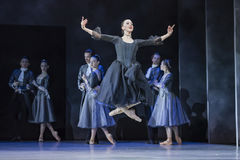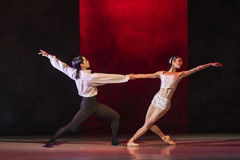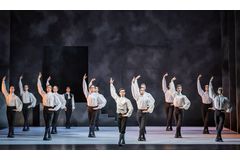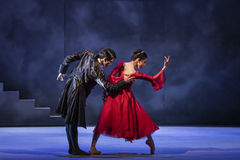Dangerous liaisons – intrigues, wile, betrayal and envy in main roles…
The latest ballet premiere at the National Moravian-Silesian Theatre in Ostrava is another well-thought-out move of the ballet company’s artistic director Lenka Dřímalová. The new production of Dangerous Liaisons is inspired by its famous theatre and silver screen predecessors. The choreographer Krzysztof Pastor admits direct inspiration by the 1988 movie directed by Stephen Frearse and starring world-famous actors such as Glenn Close, John Malkovich, Michelle Pfeiffer, Uma Thurman and Keanu Reeves. The original story about “reckless love games”, as the sub-title of the Ostrava production reads, is in fact much older – it comes from the 1782 eponymous novel by the French writer Choderlos de Laclos. Its core storyline unveils human relationships, more precisely their darker side: intrigues, wiles, envy, disappointment, sorrow, betrayal; the eternal issues that will never disappear from our lives.
The choreographer bet on top-quality cast. Koki Nishioka appeared as the treacherous and reckless, but also sensuous and charming, Vicomte de Valmont. His companion and confidant, a plotter of the highest rank, was Shino Sakurado as Marquise de Merteuil. Their relationship full of love and hate, affection and disdain, is underlined by technically strong performances of both first soloists in all variations throughout the ballet. Their dance expression was spiced up by slyness, self-content, sharp poise and gestures, but also despite of everything that surrounded them. The dramatic moments were sometimes overacted so they appeared more pathetic and pretended than credible, e.g. in the second act’s scenes of mourning over the death of a secretly loved person.
The first victim of the central couple’s perfidious plans is Cecile de Volanges impersonated by Beatrix Fernandez Moreno. It was a perfect cast. Not only does Fernandez Moreno look like an innocent and chaste girl, but her fragile and light dancing makes impression of an adolescent upper-class maid. She is accompanied on stage by her mother, Madame de Volanges (Aglaja Sawatzki) who is – in accordance with the cinematic version – rather sidelined. And even if she is granted more space, her stage presence does not seem authentic, maybe because she tries hard to act like a protective mother. The second victim is Madame de Tourvel danced by Sawa Shiratsuki. This first soloist is beyond any doubt a technically highly-skilled dancer, but her portrayal of a deeply religious and later lovelorn, broken woman adoring her own traitor was not a very convincing. On the other hand, it is not easy to keep up to Michelle Pfeiffer’s brilliant performance in the 1988 movie adaptation. The third victim becomes the noble-minded and generous Chevalier de Danceny, portrayed by Sergio Méndéz Romero who deserves all the praises I have mentioned above, however, among more mature dancers his character did not stand out.
The performance of the corps de ballet is also worth mentioning. They were given more space in the ball scenes of the first act, in the second act they took on various meanings and forms. In group passages we can recognise the detailed and precise work of the choreographer, of of the rehearsal directors, dancers, and supervision of the company’s artistic director. The variations did not suffer from any interpretational “flaws”, on the contrary, they perfectly completed the main storyline and did not seem redundant. I also appreciated the fact that the choreographer tried to be faithful to the period and one of the most frequent movements in the ball scenes were baroque bows of miscellaneous forms.
Setting the story at a ball helped Pastor define the rococo society. He managed to highlight the most important event that presented a perfect opportunity for cultivating or destroying people’s relationships. Using such strategy, the author was able to avoid retelling all the details of the original work and he could pay full attention to the five protagonists.
This sort of director’s intervention, however, presents some risks that Pastor has not been able to fully eliminate – he uncovers the plot too early and what remains are long dance passages that do not carry any particular meaning. They resemble manege or showcasing the soloists’ technique instead of developing more ideas of the story. In such a case, exalted emotions are not much of a help, for example after the break-up between Vicomte and Madame de Tourvel, when the despair of the dashed woman seems almost fake. A similar thing happens in the final scene where Marquise de Merteuil goes mad in reaction to the death of Valmont, but the dramatic letting down of her hair does not bring the desired effect.
However, this change allowed the dancers to show their best, for example in impressive quartets and quintets of the main characters that were fraught with meaning-making gestures. Pastor’s choreographic composition puts emphasis on pure and clear steps. The author avoids layering difficult moves as he prefers letting them echo and go to the fingertips. Therefore Ballet lovers can enjoy brilliant ballet technique.
The dance composition is supported by the music score. Arturs Maskats let himself be inspired by period music whose character (especially in strings parts) express a tense atmosphere - you never know when comes another blow. The score culminates in lavish dance scenes, for example in the quartet of Valmont, Madame de Tourvel, Marquise de Merteuil and Chevalier de Danceny at the end of the first act – it is a scene in which Valmont steals for good Madame de Tourvel’s heart. Maskats’a touching music also accompanies the final twist of this scene when Valmont gives Merteuil the most valuable possession of his victim – a small black cross – as evidence of the impossible coming true. He has finally seduced the most virtuous woman around.
Merteuil observes everything from distance, standing on an upstage elevated plateau with a couple of stairs leading to it. The simple scenography (by Anna Kontek) helps accentuate the dance itself, the costumes (also by Anna Kontek) tastefully highlight the characters of the individual figures. The costume Merteuil is wearing in the second act could be more refine, though – likes of her simple red dress can be spotted in every other ballet production where a daring woman is portrayed.
Dangerou Liasions is the second premiere of the season. Vzlety a pády (premiered last autumn) is conceived as a contemporary style and dance theatre triple-bill (you can read a review here), to which the new show makes a dramaturgical counterpart. The National Moravian-Silesian Theatre ballet company is broadening it repertory with another work whose quality consists in top-level performances of its dancers.
Written from the premiere held on 7 March 2019, in Antonin Dvořák Theatre.
Dangerous Liaisons
Choreography and direction: Krzysztof Pastor
Libretto: Krzysztof Pastor, Arturs Maskats
Music: Arturs Maskats
Scene and costumes: Anna Kontek
Light design: Krzysztof Pastor, Jan Tranta
Cast:
Vicomt de Valmont: Koki Nishioka
Marquise de Merteuil: Shino Sakurado
Madame de Tourvel: Sawa Shiratsuki
Chevalier de Danceny: Sergio Méndez Romero
Cecílie de Volanges: Beatriz Fernandez Moreno
Madame de Volanges: Aglaja Sawatzki
Premiere: 7 March 2019




. Foto Serghei Gherciu 2.jpg)



